Effective Solutions to Keep Squirrels Out of Flower Planters
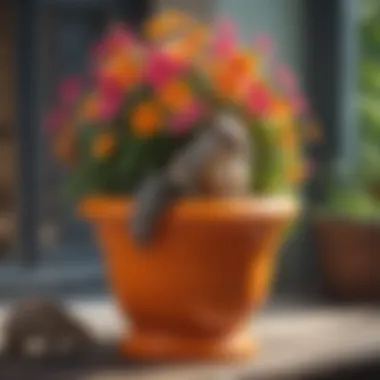
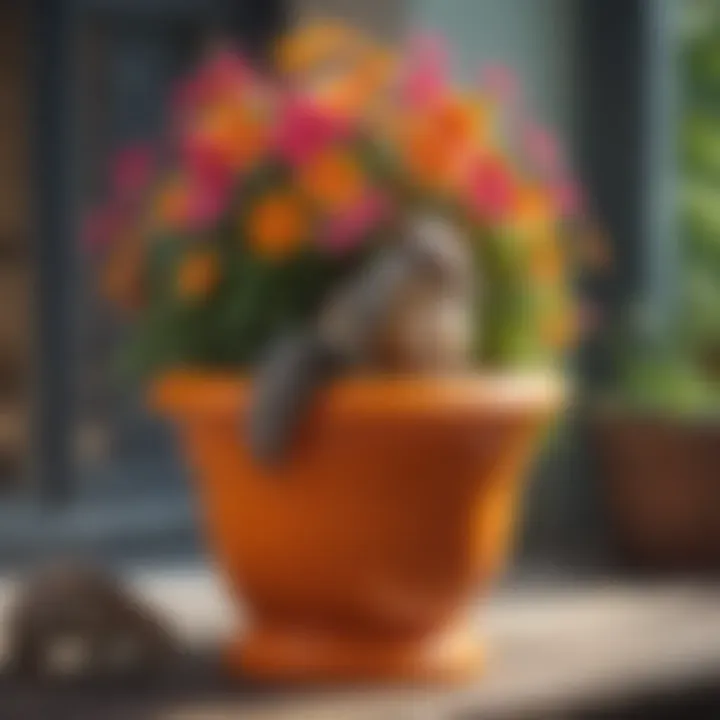
Intro
When it comes to maintaining a beautiful flower garden, many homeowners encounter the challenge of uninvited furry guests—squirrels. These creatures can wreak havoc on meticulously arranged flower planters, turning a serene garden into a battleground. Understanding the behavior of these little critters is key to developing effective strategies that protect your plants. This article dives into practical methods for deterring squirrels, focusing on diverse approaches that not only safeguard your flora but also align with sustainable gardening practices.
Through an exploration of physical barriers, repellent options, and environmental adjustments, you will be equipped with the tools necessary to reclaim your garden from these persistent pests.
"An ounce of prevention is worth a pound of cure." – A sentiment that rings particularly true when dealing with nature's intruders.
Understanding Squirrel Behavior
To formulate a successful strategy against squirrels, one must first grasp their antics. These agile animals are naturally curious and persistent. They tend to dig and forage in search of food, particularly in areas where they can spot a colorful flower. Their behavior often becomes more problematic during seasons when they are preparing for winter, as they scramble to gather resources.
Common Squirrel Actions
- Digging: Squirrels will often uproot plants searching for bulbs or seeds.
- Nesting: They might try to create nests within your planters, which may contribute to further chaos.
- Feeding: These clever critters can also munch on flowers and seeds, leading to noticeable damage to your blooms.
By understanding these habits, you can tailor your deterrent strategies to effectively disrupt their routines.
Physical Barriers
Physical barriers remain one of the most reliable deterrents when it comes to safeguarding delicate flower planters. These structures can be simple yet effective. Here are a few methods to consider:
- Netting: Lightweight mesh can keep squirrels at bay while allowing sunlight to nourish your plants. Make sure to securely anchor the edges to the ground to avoid any sneaky entries.
- Wire mesh: For more robust protection, consider placing wire mesh directly around the top of the planter. Be cautious that the holes are small enough to prevent those pesky paws from getting in.
- Cages: Building cages around your planters can act as a fortress. Using repurposed materials like old garden fencing not only serves the purpose but also adds a unique touch to your garden aesthetics.
Natural Repellents
Sometimes, a little creativity can go a long way in deterring these critters. Natural repellents utilize plant scents and other materials to discourage squirrels from indulging in your flowers. Options include:
- Cayenne pepper: Sprinkling this spicy powder around your planters can be effective. Squirrels dislike the taste and smell, potentially steering them away from their dinner plate.
- Garlic or onion: These strong-smelling kitchen staples can be brewed in water and sprayed around your plants. The odor can be off-putting for many animals, including squirrels.
- Vinegar: A homemade spray using vinegar can also serve as an effective deterrent, as squirrels often avoid areas with these strong odors.
Environmental Modifications
A change in the environment may also help deter squirrels from getting too comfortable in your garden. Here are a few modifications to consider:
- Remove food sources: Ensure that your gardening area is devoid of fallen fruits, nuts, or seeds, which can attract squirrels in the first place. Regular cleaning is essential.
- Plant selection: Certain plants can act as natural repellents. Consider incorporating species that are known to be less appealing to squirrels, such as daffodils, marigolds, or lavender.
- Noise deterrents: Some garden enthusiasts swear by placing wind chimes, shiny aluminum foil strips, or even hanging old CDs around their planters. These items not only add a touch of decoration but also create movement and sound that can scare away potential intruders.
Navigating the challenges posed by squirrels can feel like a Sisyphean task; however, with a thoughtful approach, gardeners can develop strategies that work. Keeping your flower planters safe and beautiful is within reach.
Understanding the Squirrel Behavior
Understanding squirrel behavior is a crucial first step for anyone looking to protect their beloved flower planters from these nibbling nuisances. Squirrels are not just cute little creatures scurrying around, they possess an array of instincts and behaviors that influence their interactions with the environment, especially gardens. Knowing why they might target your flower planters can shed light on effective prevention strategies. From their insatiable curiosity to their natural feeding habits, every aspect of their behavior offers clues on how to keep them at bay.
Why Squirrels Target Flower Planters
Squirrels are opportunistic feeders, always on the lookout for an easy meal. Flower planters often become their prime targets for several reasons:
- Availability of Food: Flower planters usually contain not just blooming flowers but also seeds and bulbs, which are like a buffet to squirrels. They are clever enough to realize that these planters often offer a reliable food source, particularly in spring and early summer when new growth appears.
- Ideal Nesting Spots: The rich soil in planters might attract them to dig and stash food, as burying food is part of their instinctual behavior. Additionally, if there are any nesting materials, such as dry leaves or twigs, right in your planters, it further exacerbates the issue.
- Heightened Curiosity: Squirrels are naturally curious animals. They tend to explore every nook and cranny of their domain. Planters are often placed in accessible locations, making them an easy target for inspection.
"Squirrels' innate curiosity can lead them to your flower planters as they investigate potential food sources."
By recognizing these motivations, gardeners can tailor strategies that cater to these instincts, making it harder for squirrels to invade their precious flower displays.
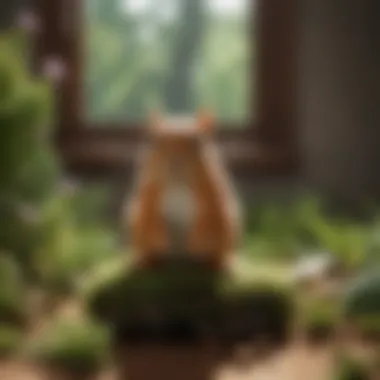
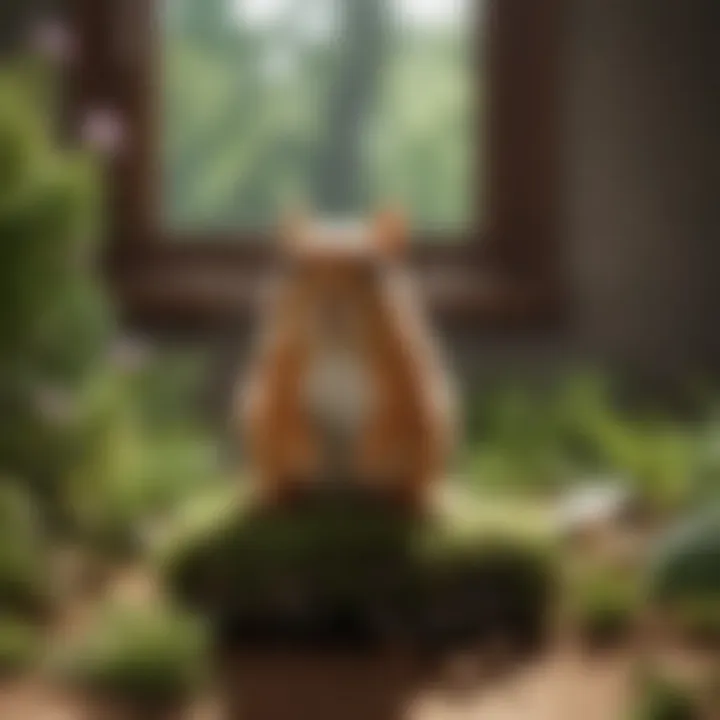
Typical Feeding and Nesting Habits
When it comes to feeding, squirrels are relentless. Their diet mainly consists of nuts and seeds, but they have been known to indulge in a variety of items, from fruits to flowers and even vegetables if they’re feeling particularly bold. This adaptability increases their likelihood of targeting flower planters.
- Feeding Rituals: Squirrels often feed in the early morning and late afternoon. Understanding their active times can help in planning the times when preventive measures might be most effective.
- Nesting Behavior: As the seasons change, squirrels look for suitable nesting materials. They might take dry grass, leaves, or even flower petals to line their nests. Flower planters provide an easily accessible source of these materials, leading to further damage.
It is important to be mindful of these habits. A clearer understanding of why squirrels are drawn to flower planters will lead to more successful deterrent measures that not only secure the plants but also keep the garden flourishing.
Assessing the Damage Caused by Squirrels
Assessing the damage caused by squirrels is a crucial step in understanding the impact these pesky little critters can have on your beloved flower planters. By identifying the specific types of damage that may occur, gardeners can tailor their preventive strategies and mitigate the risks effectively. Ignoring the possible harms might lead to frustration and disappointment, especially after investing time and resources into cultivating a vibrant garden. So, let's dive into the specifics, shall we?
Physical Damage to Plants
Squirrels have a knack for coming unsought into flower planters, leading to a range of physical damage. For instance, they might dig through the soil in search of bulbs or seeds, uprooting young plants in the process. This physical disturbance often results in crunchy stems and disheveled foliage, not to mention an unsightly mess. Furthermore, squirrels may chew on the plants themselves, stripping leaves off and sometimes taking bites out of stems, causing irreversible harm to fragile blooms. Here are some common forms of physical damage caused by squirrels:
- Root disruption: Young plants often have shallow roots, making them particularly vulnerable to being uprooted by squirrel digging.
- Leaf and stem damage: Squirrels may strip, nibble or even take substantial portions of plants away, leaving them exposed and less healthy.
- Nest building: If squirrels decide to take a liking to your planters, they may use the soil and plants to build nests, destroying the planter's aesthetic entirely.
Understanding these forms of damage helps gardeners become aware and make informed decisions about their deterrent methods.
Impact on Soil and Plant Health
In addition to direct harm to the plants themselves, squirrels can affect the soil health and overall condition of a garden. When squirrels dig in the soil, they not only uproot the plants but also interfere with the soil structure, creating air pockets that hinder water retention. This disruptive digging can lead to poor drainage and drying out of the soil, ultimately affecting plant sustenance. The following points illustrate the implications of squirrel activity on soil and plant health:
- Nutrient depletion: Disturbance of the soil can bring nutrients to the surface, where they might wash away or become inaccessible to plants.
- Soil compaction: Constant digging and trampling can lead to compacted soil, making it harder for plants to establish deep roots.
- Increased vulnerability: Damaged plants often become more susceptible to pests and diseases, heralding a cycle of decline.
The overarching message is that the damage caused by squirrels goes beyond the immediate visual impact. It can set the stage for a ripple effect that could impact not just the current bloom but the entire garden ecosystem in the long run. To safeguard your flower planters, it's essential to consider these potential damages and take appropriate measures to deter squirrels before they become a prominent nuisance.
"Understanding the consequences of squirrel activity in your garden is key to cultivating healthy, flourishing plants and maintaining the beauty of your flower planters."
In sum, being aware of the damage inflicted by squirrels helps you grasp the urgency in implementing effective defense mechanisms. As we progress through this article, we will explore various strategies and ways to protect your plants from these furry little intruders.
Physical Barriers to Prevent Squirrel Access
Creating physical barriers is one of the most effective strategies in the ongoing battle against squirrels invading flower planters. While these lively little creatures can be entertaining to watch, their penchant for digging, uprooting, and nibbling on plants can turn a beautiful garden into a battlefield. By employing physical deterrents, you introduce a robust line of defense that protects your botanical investments from their relentless curiosity and appetite.
Utilizing such barriers not only safeguards your plants from immediate damage, it also reduces the chances of having to constantly replant or restore lost foliage. Additionally, these measures can help in long-term planning for garden aesthetics, as they often blend seamlessly with landscape design when done right.
Using Wire Mesh and Fencing
Wire mesh serves as a formidable obstacle to squirrels. This material, often regarded as simple and utilitarian, can be invaluable in your gardening arsenal. When installing wire mesh around your planters, the key is to use a fine mesh that has holes small enough to thwart even the tiniest of squirrels from squeezing through.
Benefits:
- Durability: Wire mesh stands the test of time, resisting weathering and tearing from animal interference.
- Customization: It can be shaped to fit various planter sizes, allowing for a tailored fit.
- Ease of Installation: Setting up wire fencing is often a straightforward DIY task that doesn’t require specialized skills.
However, it’s crucial to bury the mesh a bit into the soil to prevent the critters from digging underneath and still getting to your precious plants. In some cases, adding wooden or metal stakes can enhance the overall stability of the barrier.
Placing Mesh Netting Over Planters
Another simple yet effective deterrent is using mesh netting. This can be particularly useful during the planting season when seedlings are most vulnerable. By covering your flower planters with bird mesh or garden netting, you create a physical barrier that squirrels can't penetrate easily.
Things to Consider:
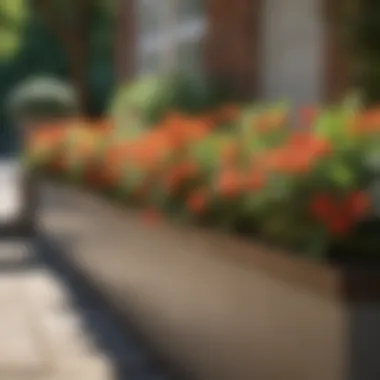
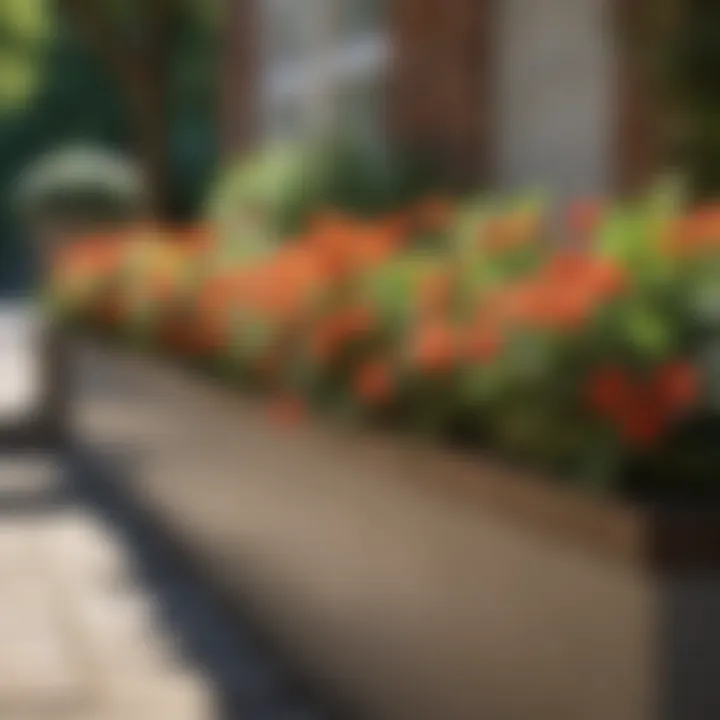
- Accessibility for Pollinators: Ensure that your netting doesn't completely block important pollinators like bees from accessing your flowers, as they are critical for the health of your plants.
- Material Choice: Opt for lightweight netting that doesn't damage delicate young plants but provides enough resistance to deter squirrels.
- Securing the Edges: It's vital to anchor down the edges of the netting to prevent squirrels from slipping under. This might involve using stakes or weights around the perimeter.
Strategic Height Placement of Planters
Sometimes, the best defense is a good offense, particularly when it comes to the height of your planters. Elevating your flower planters makes it difficult for squirrels to reach them. If you have the option, place planters on stable tables or raised beds that will keep them well out of reach.
Considerations for Height Placement:
- Safety: Ensure that the raised areas are stable to avoid any accidents.
- Aesthetic Appeal: Elevated planters can add a unique vertical dimension to your garden design, enhancing visual interest.
- Health Benefits for Plants: Planters that are raised often have better drainage and air circulation, which can lead to healthier plants overall.
Placing planters this way may not completely end squirrel activity, but it can reduce the frequency with which they target your prized flowers.
Natural Repellents for Squirrel Deterrence
When it comes to keeping squirrels away from your beloved flower planters, natural repellents often come into play as a favored strategy. Unlike chemical alternatives, which can pose risks to both plants and wildlife, natural options are generally safer and can be quite effective. They also tend to be more appealing to environmentally conscious gardeners who prefer sustainable methods to mitigate these pesky intruders. The right natural repellent not only deters squirrels but also promotes a healthier garden ecosystem.
Using repellents made from natural ingredients can minimize interference with the surrounding fauna and mitigate any negative environmental impacts. It is essential to highlight that while they may not provide a foolproof solution, they can significantly reduce squirrel activity when utilized as part of a broader strategy. This approach usually includes combining these repellents with other prevention methods, such as physical barriers or modifications in the garden layout.
Essential Oils and Their Efficacy
Essential oils can pack quite a punch when it comes to deterring squirrels. Many homeowners find that these concentrated extracts have the ability to disrupt the natural instincts of these animals. Oils such as peppermint, rosemary, and citrus are particularly noted for their potent scents, which squirrels typically dislike. It’s not just the aroma that does the trick; the specific compounds present in these oils might also be irritating to squirrels, encouraging them to steer clear of treated areas.
Applying essential oils can be done in various ways.
- Soaking Cotton Balls: One effective method is to soak cotton balls in a chosen essential oil and place them around your flower planters. This method allows for a sustained release of the scent over time.
- Spray Solutions: Another way is to mix a few drops of essential oil with water in a spray bottle and lightly mist the plants. This has the added benefit of hydrating the flowers while delivering the repelling scents.
Keep in mind that essential oils may need to be reapplied, especially after rain or heavy watering. Frequent checking of the planters is vital to maintain the efficacy of the repellents.
Homemade Solutions Using Spices
Creating homemade repellent solutions using everyday spices can be a fun and effective way to discourage squirrels without incurring extra costs. Spices that are pungent or have strong smells, such as cayenne pepper, cinnamon, and garlic powder, can serve as effective barriers when sprinkled around your flowers. Here are some ways to utilize these products:
- Sprinkle Directly: Simply sprinkling cayenne pepper around the base of your flower planters can create an unwelcoming environment for squirrels. They dislike the heat of this pepper, causing them to keep their distance.
- DIY Spice Water: Make a spicy concoction by mixing hot water with cayenne or crushed red pepper flakes. Allow it to steep for a few hours, then strain and spray onto your plants. Again, this method not only imparts the repellent properties but also provides hydration.
These spice-based solutions not only deter squirrels but can also enrich the soil as they eventually decompose. They are natural, cheap, and reinforce a sustainable garden strategy, supporting the health of your garden in multiple ways.
Natural repellents offer a safe, effective way to deter squirrels, championing a holistic approach for the garden.
In summary, employing natural repellents like essential oils and spices can dramatically shift the balance in favor of the garden enthusiast seeking to keep squirrels at bay. They are methods that align with the goals of maintaining a harmonious garden while defending against intruders.
Environmental Modifications to Discourage Squirrels
Altering the environment is a wise approach when dealing with those pesky squirrels eyeing your flower planters. By making strategic modifications in your garden, you can create an unwelcoming territory for these critters. This not only protects your plants but also fosters a more vibrant ecosystem that benefits your garden in other ways. Consider it an all-encompassing strategy: not only do you keep squirrels at bay, but you also enhance your gardening experience while doing it.
Maintaining a Clean and Tidy Garden Space
One of the simplest yet impactful methods to deter squirrels is to uphold a spotless garden space. Squirrels are drawn to clutter, which often provides hiding spots and access to additional food sources like fallen nuts or fruits. Keeping your garden tidy involves:
- Regularly removing debris such as fallen leaves and fruits.
- Ensuring that garbage bins are securely closed and located away from your planting areas.
- Clearing any overgrown grass or weeds which can create plenty of safe havens for these creatures.
"An orderly garden is less like a welcome mat and more like a closed door to the furry invaders."
Adopting a routine of cleanliness can shift the focus away from your flower planters, compelling squirrels to seek out easier targets. In doing so, you’ll not only discourage their presence but also cultivate a healthier growing environment for your plants, reducing pests and diseases.
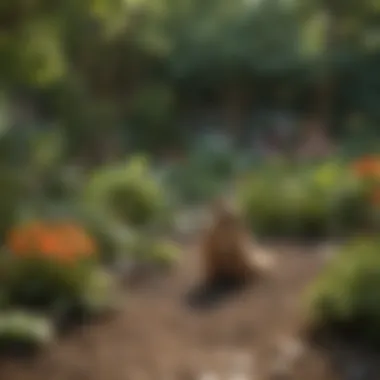
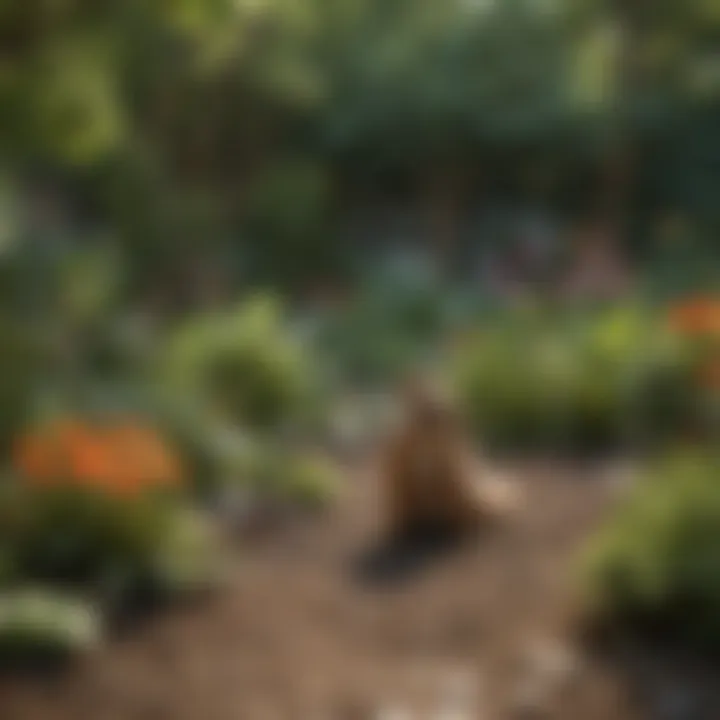
Reducing Other Food Sources Nearby
If your yard resembles an all-you-can-eat buffet, squirrels won’t hesitate to indulge. Reducing the availability of food sources nearby is crucial. Take note of these strategies to diminish their options:
- Bird feeders and pet bowls: If you're feeding feathered friends, consider using squirrel-proof bird feeders. Also, remove any pet food left outside after meal times.
- Fruit trees: If you have fruit-bearing trees, tidy up fallen fruits that may attract these little foragers.
- Compost bins: Make sure that compost bins are closed tightly to prevent squirrels from rummaging through them for scraps.
By starving the squirrels of their easy meals, you effectively push them to search for less appealing neighborhoods far from your well-kept flower planters.
Utilizing Companion Planting Techniques
Another thoughtful strategy lies in the ancient method of companion planting. By planting certain species together, you can create an environment that squirrels will think twice about invading. Some pairings to consider include:
- Nasturtiums with your favorite blooms: The strong scent may deter squirrels while attracting beneficial insects.
- Garlic or onions mixed in: Their taste and smell are off-putting to many pests, including squirrels.
- Mint plants: The aroma can confuse and repel them while also adding a pleasant touch to your garden.
The right companion plants can create a natural barrier that may just give squirrels a reason to scurry off in search of a less aromatic locale. Thus, these plants not only add visual appeal to your flower planters but also serve a tactical purpose.
In summary, environmental modifications serve as a cornerstone in discouraging squirrel activity. Cleanliness, food source management, and clever companion planting create a formidable defense. Keep these steps in mind as you craft a peaceful sanctuary for your flora.
Detecting and Addressing Squirrel Activity
When battling the furry nuisances known as squirrels, detecting their activity becomes vital for homeowners who want to shield their flower planters. Understanding when and where these critters invade helps in crafting effective responses. If you know the telltale signs of their presence, you can nip problems in the bud before they get out of control. This proactive approach serves as a cornerstone in safeguarding your garden.
Identifying Signs of Squirrel Presence
Squirrels aren’t exactly shy, but they are skilled in their mischief. It helps to familiarize yourself with the signs that point to their activity around your garden. Here are some indicators to watch for:
- Nibbled Leaves and Buds: Chewed edges on leaves or missing buds could signal that squirrels have been in the area, taking more than just a passing glance at your plants.
- Digging Around Planters: If you notice displaced soil or disturbed roots, these little bandits might be searching for buried treasures or leaving a calling card.
- Nest Materials: Look for signs of nesting materials such as twigs, leaves, or even shredded paper that squirrels might use to build cozy nests nearby.
- Typical Sounds: A rustling sound or scurrying in foliage, especially during dawn or dusk, may indicate their presence. Their chatter can also give them away—squirrels can be quite vocal!
- Footprints and Claw Marks: Inspect soil and soft surfaces for small paw prints resembling tiny hands with sharp claws, which could help affirm their presence.
By staying alert and observant, you get a jumpstart on solving any current squirrel issues or preventing future ones, leading to healthier flower planters and plants overall.
Monitoring Effectiveness of Strategies
After laying down the groundwork to deter squirrels, keeping tabs on how well your strategies work is essential. Monitoring allows you to stay adaptive in your approach. Here’s how to go about it:
- Routine Checks: Regularly inspect your flower planters post-deployment of physical barriers or repellents. If plants are still being nibbled or disturbed, it might be time to reassess your tactics.
- Document Changes: Keeping track of changes in squirrel activity can be very telling. Jot down dates of unusual sightings, nibbling patterns, or days when you notice empty planters after intense interventions.
- Experiment With Strategies: Don’t hesitate to mix and match your approach. If essential oils don’t seem to work well at first, try incorporating a physical barrier in addition to them. Observing which combinations yield the best results can inform your future strategies.
- Seek Feedback: If you live in a community with neighbors struggling with the same issue, consider sharing your experiences. Online platforms like reddit.com can serve as a treasure trove of tips and tricks from others who have been through the wringer with squirrels.
By employing an ongoing review process, you not only stand a chance at improving your current strategies but also contribute to a more squirrel-resistant home garden over time. Monitoring squirrel activity ensures you're on the front foot, rather than playing catch-up with these crafty little critters.
Closure: Creating a Squirrel-Resistant Garden
Creating a squirrel-resistant garden is more than just a reaction to an immediate problem; it’s a thoughtful integration of various strategies that reflect both respect for wildlife and a desire for a flourishing garden. The key to long-term success involves a comprehensive approach that blends physical deterrents, natural repellents, and environmental adjustments. By understanding the habits of squirrels, you’ll be in a better position to outsmart them and protect your precious flowers.
Attaining a squirrel-resistant garden requires an ongoing commitment. It’s not about one-off solutions; instead, think of a multi-pronged strategy that evolves. For example, setting up physical barriers like wire mesh is effective, but complementing this with an appropriate mix of natural repellents—like peppermint oil or cayenne pepper—can reinforce your defenses against these persistent creatures.
Comprehensive Approaches for Long-Term Success
To truly deter squirrels from your flower planters, diversity in your approach is essential. Here are some strategies that can lead to sustainable results:
- Implement Physical Barriers: Utilize fencing, netting, and other structures that physically block squirrel access to your plants.
- Apply Natural Repellents: Regularly use essential oils or spicy substances that squirrels find unpleasant, keeping them at bay naturally.
- Environmental Awareness: Monitor food sources and nesting areas in your vicinity. Keeping a clean garden and reducing attractants can have a significant impact.
- Seasonal Adjustments: Adapt your strategies seasonally. For instance, certain methods might work better in spring as squirrels are more active looking for food.
- Regular Monitoring: Observing the effectiveness of your strategies is crucial. If you notice an uptick in squirrel activity, be ready to tweak your approach based on what seems to be working.
All these actions combined reinforce a culture in your garden that not only discourages squirrels but embraces sustainable and eco-friendly practices.
The Balance Between Nature and Personal Space
Finding equilibrium between maintaining your garden’s aesthetic and respecting the local ecosystem is critical. Squirrels are often a vital part of our urban wildlife and contribute to seed dispersal and plant diversity. But that doesn’t mean they can run wild in your flower planters. Here’s how to strike that balance:
- Mindful Plant Selection: Choose plants that can thrive despite incidental nibbling while still providing beauty.
- Sustainable Practices: Instead of chemical repellents, consider using methods that align with organic gardening principles. This builds a healthy garden ecosystem.
- Educate Yourself and Neighbors: Share knowledge about effective deterrent strategies within your community. This collective awareness can lead to broader solutions in your neighborhood.
“A well-tended garden is not just about blooms; it’s about creating an environment that respects all forms of life.”















